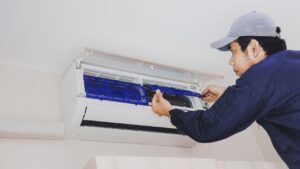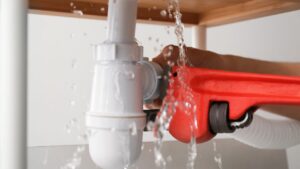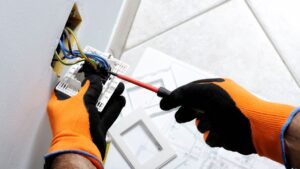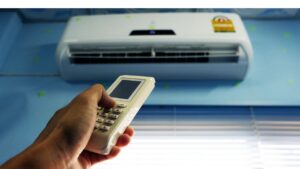Purchasing an air conditioner in Singapore can feel overwhelming. It’s a significant investment, not just in terms of money, but in the future comfort and liveability of one’s home. There are also many jargon like “BTUs,” “inverters,” and “System 3s”, etc.
1. Which Type Of Aircon Is Right For You?
The most fundamental choice when buying an air conditioner is selecting the right type. This decision hinges on housing type, cooling needs, budget, and long-term plans. In Singapore, the options primarily boil down to highly popular split systems, and the more niche window and portable units.
Split Systems Explained
Split system air conditioners are, by a significant margin, the most popular and practical choice for Singaporean homes, especially HDB flats and condominiums.
Their defining characteristic is a design that separates, or “splits,” the system into two main components: an indoor unit and an outdoor unit.
The indoor unit, often called the fan coil or evaporator, is mounted on the wall inside the room and is responsible for blowing cool air.
The outdoor unit, which contains the noisy compressor and condenser, is installed outside, typically on a dedicated aircon ledge. This separation is the key to their primary advantage: quiet indoor operation, as the main source of noise is kept outside the living space.
Multi-Split Systems
A multi-split system connects multiple indoor units, typically from two to five to a single, powerful outdoor unit. This is the go-to solution for cooling an entire apartment, as it saves an immense amount of valuable space on the aircon ledge.
The prevalence of multi-split systems has given rise to a unique Singaporean market terminology that directly aligns with the standardized layouts of HDB flats. Instead of complex configurations, retailers offer bundled packages known as “System 2”, “System 3”, “System 4” and so on.
- System 2: One outdoor unit connected to two indoor units. Ideal for smaller HDB flats or for cooling two main rooms, like a bedroom and a study.
- System 3: One outdoor unit connected to three indoor units. A very common choice for 3-room or 4-room HDB flats, perfectly suited for cooling three separate bedrooms.
- System 4 & 5: One outdoor unit connected to four or five indoor units, respectively. These are designed for larger residences like 5-room flats, executive apartments, or condos, providing comprehensive cooling for multiple bedrooms and a living room.
The Quick & Simple Options: Window vs. Portable Aircons
While split systems dominate the residential market, window and portable units serve specific, often temporary, needs.
Window Units
A window air conditioner is a self-contained, single-box unit that is installed within a window frame or a purpose-built opening in a wall. All components, including the compressor, are housed within this single unit.
- Pros: The primary advantages are a lower upfront purchase price and a relatively simple installation process compared to split systems. This makes them a viable budget solution for cooling a single room, especially in rental situations where major modifications are not allowed.
- Cons: Their all-in-one design makes them significantly noisier, as the compressor is effectively inside the room. They are also generally less energy-efficient, leading to higher electricity bills over time, and they obstruct window space, which reduces natural light and ventilation. It is also worth noting that HDB generally discourages the installation of window units due to aesthetic and noise concerns that can affect neighbours.
Portable Units
Portable air conditioners are free-standing units on wheels, offering the ultimate flexibility. They function by drawing in warm air from the room, cooling it, and expelling the collected hot air and moisture outside through a large exhaust hose that must be vented through an open window or sliding door.
- Pros: Their key benefit is mobility. They can be moved from room to room as needed and require no permanent installation, making them an excellent choice for renters, for cooling small spaces like a server room, or as a temporary stop-gap solution.
- Cons: Portable units are the least efficient and least powerful type of air conditioner. They can struggle to cool anything larger than a small room, especially during peak heat. They are also the noisiest of all options and take up valuable floor space, which can be a significant drawback in smaller Singaporean apartments.
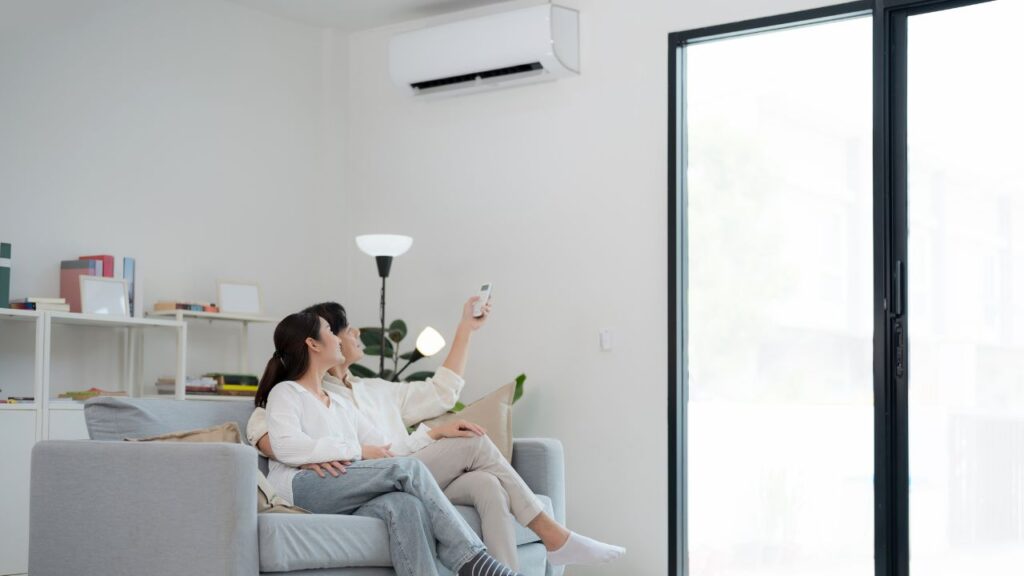
2. Getting the Size Of The Aircon Right
After deciding on the type of aircon, the next step is arguably the most critical for ensuring both comfort and cost-effectiveness: choosing the right size. In the world of air conditioning, “size” doesn’t refer to the physical dimensions of the unit but to its cooling capacity, measured in British Thermal Units, or BTUs.
The consequences of incorrect sizing are severe and can undermine all other good purchasing decisions.
Undersized (Too Small): If the aircon’s BTU capacity is too low for the room, it will be forced to run continuously at maximum power in a futile attempt to reach the desired temperature. This not only fails to cool the room effectively on hot days but also leads to sky-high electricity bills and puts immense strain on the compressor, drastically shortening the unit’s lifespan.
Oversized (Too Big): A unit that is too powerful for the space presents a different, more insidious problem. It will blast the room with cold air, reaching the target temperature very quickly and then shutting off. This process, known as short-cycling, is highly inefficient.
More importantly, because the runtime is so short, the aircon doesn’t have enough time to perform its secondary function: dehumidification. This leaves the room feeling cold but damp, clammy, and uncomfortable. This excess moisture can also lead to problems with mould and mildew over time.
Calculating The BTU You Need
Fortunately, there is a straightforward formula that serves as an excellent starting point for determining the required BTU for Singapore’s specific climate.
Step 1: Measure Your Room. Using a measuring tape, find the length and width of the room you intend to cool. It’s best to do this in metres (m).
Step 2: Calculate the Area. Multiply the length by the width to get the room’s area in square metres (m2). For example, a typical HDB common bedroom might be 4 metres long by 3 metres wide, giving it an area of
- 4m × 3m = 12m²
Step 3: Apply the Magic Number. For Singapore’s hot and humid conditions, a widely accepted rule of thumb is to multiply the room’s area in square metres by a factor of 500. This gives the base BTU required.
Example Calculation: For the 12m² bedroom, the base BTU needed would be:
- 12m² × 500 = 6,000BTU
Adjusting BTU Based On Factors Beyond Room Size
The base calculation provides a solid foundation, but it assumes an empty, perfectly average room. Real-world conditions demand adjustments to fine-tune the BTU estimate for accuracy.
- Sunlight Exposure: This is a major factor. If the room is particularly sunny, especially if it has large windows facing west and receives intense afternoon sun, the heat load is significantly higher. In this case, it is recommended to add 10% to the base BTU calculation.
- Occupancy: Humans generate heat. The base calculation generally accounts for one or two people. For each additional person who will regularly occupy the room, add 600 BTU.
- Other Heat Sources: While harder to quantify, be mindful of other factors. A room with high ceilings contains more air volume to cool. A room with multiple heat-emitting electronics, such as a high-end gaming PC, large-screen TVs, and extensive lighting, will also have a higher heat load and may require a slight upward adjustment in BTU.
After making these adjustments, the final number should be rounded up to the nearest standard aircon size available in the market, which are typically 9,000, 12,000, 18,000, and 24,000 BTU. For example, if a calculation results in 11,000 BTU, a 12,000 BTU unit should be chosen.
BTU Needs for Typical HDB Rooms
| Room Type | Typical Size (sqm) | Recommended BTU |
| Common Bedroom / Study | up to 15 | 9,000 |
| Master Bedroom / Small Living Room | 16 – 23 | 12,000 |
| 4-Room HDB Living Room | 24 – 30 | 18,000 |
| 5-Room HDB Living Room / Open-Concept | 30+ | 22,000 – 24,000 |
3. Inverter vs. Non-Inverter & The NEA Tick Rating
Understanding the technology inside an air conditioner is the key to unlocking long-term savings and superior comfort. The two most important concepts for a Singaporean buyer to grasp are the difference between inverter and non-inverter technology, and the meaning behind the National Environment Agency (NEA) tick rating system.
Inverter vs. Non-Inverter
At the heart of any air conditioner is the compressor, the engine that drives the cooling process. How this compressor operates defines whether the unit is an “inverter” or “non-inverter” model, a distinction that has profound implications for energy use, comfort, and durability.
The Non-Inverter
A non-inverter aircon works on a simple, fixed-speed principle, much like a light switch: it’s either fully ON or completely OFF. When the room temperature rises, the compressor kicks in at 100% power, running at full blast to cool the space. Once the thermostat’s set temperature is reached, the compressor shuts down entirely. This aggressive start-stop cycle repeats continuously to maintain the temperature.
- Pros: The primary and only significant advantage is a lower upfront purchase price, making it seem like a budget-friendly option.
- Cons: This “all or nothing” approach is inefficient. The constant restarting of the compressor consumes a large jolt of electricity each time, leading to higher energy consumption. It also creates noticeable temperature swings as the room gets cold then warm again. The mechanical stress from these frequent, jarring starts and stops leads to more noise and a shorter operational lifespan for the unit.
The Inverter
Inverter technology is a far more sophisticated and intelligent approach. It is best understood with the analogy of a car’s accelerator pedal. An inverter aircon is equipped with a variable-speed compressor. When switched on, it runs at high speed to cool the room down quickly. However, as it approaches the target temperature, it does not shut off. Instead, it slows down the compressor speed, “cruising” at a very low power level to precisely and continuously maintain the desired temperature.
- Pros: The benefits are substantial. By avoiding the energy-guzzling start-stop cycles, inverter units are vastly more energy-efficient, capable of reducing electricity consumption by 30-50% compared to non-inverter models. This results in significantly lower monthly bills.
The continuous operation also ensures a stable, consistent room temperature without uncomfortable fluctuations. Furthermore, the system runs much more quietly and experiences less wear and tear, giving it a longer lifespan.
- Cons: The main drawback is a higher initial purchase cost due to the more advanced technology.
The Verdict for Singapore: For any household that uses air conditioning on a regular or daily basis, which is the vast majority in Singapore, the inverter model is the undisputed winner. The long-term savings on electricity bills will comfortably eclipse the higher upfront cost, often within a few years, making it a far superior financial and environmental investment.
Decoding the NEA Energy Label: What the 5 Ticks Really Mean
To help consumers make energy-wise decisions, the NEA has implemented a mandatory Energy Label for all air conditioners sold in Singapore. This label provides a simple, at-a-glance guide to a unit’s efficiency, using a system of one to five ticks.
The rule is simple: the more ticks, the more energy-efficient the appliance. This means a 5-tick aircon uses the least amount of electricity to produce the same amount of cooling as a lower-rated model. This difference is not trivial; it translates directly into significant cost savings.
- 1-Tick (Very Low Efficiency): Estimated monthly cost of $90 – $100.
- 3-Tick (Moderate Efficiency): Estimated monthly cost of $60 – $70.
- 5-Tick (Very High Efficiency): Estimated monthly cost of $40 – $50.
These estimates, based on 8 hours of daily use, reveal a stark reality: choosing a 5-tick model over a 1-tick model could cut running costs by more than half, potentially saving a household over $500 a year.
The technical metric behind this rating is the Cooling Seasonal Performance Factor (CSPF), which measures efficiency across a range of temperatures, but for the average consumer, focusing on the number of ticks is all that is needed.
The government has been actively pushing the market towards greater efficiency by raising the Minimum Energy Performance Standards (MEPS). This means that the least efficient models are progressively being phased out. For instance, 1-tick aircons are no longer permitted for sale, and from April 2025, the minimum requirement for single-split systems will be raised to the 4-tick level, and for multi-split systems to the 5-tick level.

4. Your Installer is More Important Than Your Brand
A crucial truth that is often overlooked in the excitement of choosing a new air conditioner is this: the quality of the installation is more important than the brand of the unit itself. A premium, expensive aircon can be crippled by a poor installation, while a standard unit can perform optimally for years if installed correctly.
Common problems stemming from substandard installation are rampant and include:
- Refrigerant Leaks: Often caused by poorly joined or low-quality copper pipes, leading to a loss of cooling performance and requiring costly top-ups.
- Water Leakage: Clogged or improperly installed drainage pipes can cause water to overflow from the indoor unit, potentially damaging walls and furniture.
- Incorrect Wiring: Inexperienced technicians have been known to wire the wrong indoor units to the compressor splits, resulting in smaller rooms getting too cold while larger rooms remain warm.
- Excessive Noise and Vibration: Improper mounting of the outdoor or indoor units can lead to rattling and vibrations.
The difference between a quality installation and a poor one often comes down to the materials used.
- Copper Pipes: These pipes circulate the refrigerant gas between the indoor and outdoor units. Modern refrigerants like R32 and R410A operate at very high pressures. Thicker copper pipes, specified by their Standard Wire Gauge (SWG), are essential to withstand this pressure and prevent leaks. Quality installers use thicker SWG 22 or even SWG 21 pipes, whereas cheaper quotes may involve thinner, leak-prone SWG 23 pipes.
- Insulation: In Singapore’s incredibly humid climate, insulation is non-negotiable. The copper pipes carrying the cold refrigerant will cause moisture in the air to condense on their surface. High-quality, thick foam insulation (e.g., 1/2-inch Armaflex) is required to prevent this “sweating.” Inferior or thin (e.g., 3/8-inch) insulation will lead to condensation, which can result in dripping water, damage to walls and furniture, and mould growth. It also causes energy loss, making the system less efficient.
- Drainage Pipes: The indoor unit produces condensation water that must be drained away. Quality installations use larger diameter PVC drainage pipes (16mm instead of the smaller 13mm) and ensure they are properly angled to allow for smooth water flow, reducing the risk of clogging and water leakage.
- Brackets: The outdoor condenser unit is heavy and exposed to the elements. Using durable, corrosion-resistant stainless steel brackets is a critical safety measure. Cheaper installations might use standard galvanized steel brackets, which are prone to rusting and could fail over time, posing a serious safety hazard.
To avoid things going wrong during installation of your aircon, homeowners should meticulously vet their installation company.
Or if you are interested in the cost of actually installing an aircon, read our cost guide to aircon installation in Singapore.






